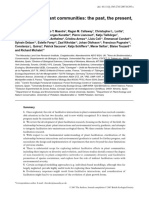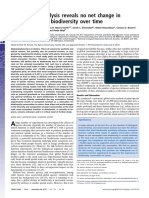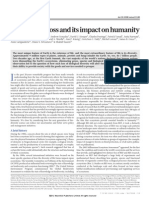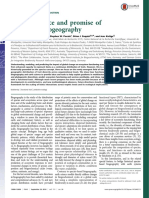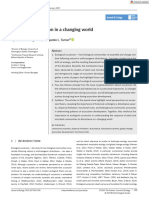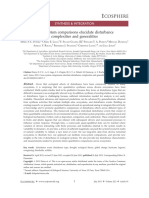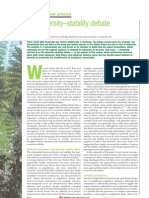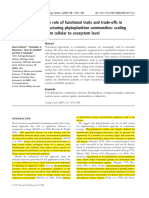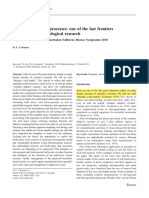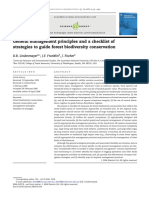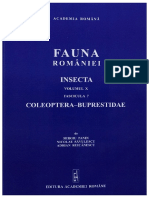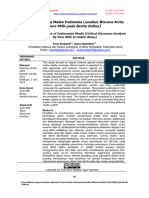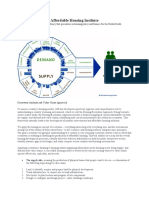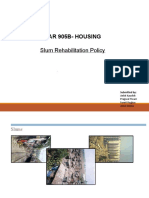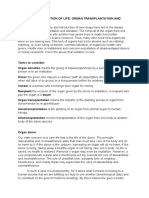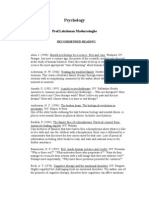Lore Au 2001
Lore Au 2001
Uploaded by
Ionut MarianCopyright:
Available Formats
Lore Au 2001
Lore Au 2001
Uploaded by
Ionut MarianCopyright
Available Formats
Share this document
Did you find this document useful?
Is this content inappropriate?
Copyright:
Available Formats
Lore Au 2001
Lore Au 2001
Uploaded by
Ionut MarianCopyright:
Available Formats
SCIENCE’S COMPASS ● REVIEW
REVIEW: ECOLOGY
Biodiversity and Ecosystem Functioning:
Current Knowledge and Future Challenges
M. Loreau,1* S. Naeem,2 P. Inchausti,1 J. Bengtsson,3 J. P. Grime,4 A. Hector,5 D. U. Hooper,6 M. A. Huston,7 D. Raffaelli,8
B. Schmid,9 D. Tilman,10 D. A. Wardle4
primary production in grassland ecosystems
The ecological consequences of biodiversity loss have aroused considerable interest (20–23). Because plants, as primary produc-
and controversy during the past decade. Major advances have been made in describing ers, represent the basal component of most
the relationship between species diversity and ecosystem processes, in identifying ecosystems, they represented the logical
functionally important species, and in revealing underlying mechanisms. There is, place to begin detailed studies. Several, al-
however, uncertainty as to how results obtained in recent experiments scale up to though not all, experiments using randomly
landscape and regional levels and generalize across ecosystem types and processes. assembled communities found that primary
Larger numbers of species are probably needed to reduce temporal variability in production exhibits a positive relationship
ecosystem processes in changing environments. A major future challenge is to with plant species and functional-group di-
determine how biodiversity dynamics, ecosystem processes, and abiotic factors
Downloaded from http://science.sciencemag.org/ on May 28, 2018
versity (Fig. 1).
interact. These results attracted a great deal of
interest, not only because they were novel,
but also because they seemed counter to pat-
T
he relationship between biodiversity the current debate in which scientists dis- terns often observed in nature, where the
and ecosystem functioning has emerged agree about the relative importance of func- most productive ecosystems are typically
as a central issue in ecological and tional substitutions and declining species characterized by low species diversity (26,
environmental sciences during the last de- richness as determinants of changes in eco- 27). The controversy over the interpretation
cade. Increasing domination of ecosystems system functioning. Comparative studies of these results started with the realization
by humans is steadily transforming them into have begun to reveal the extent to which that they can be generated by different mech-
depauperate systems (1, 2). Because ecosys- functional substitutions alter ecosystem anisms. The mechanisms discussed so far
tems collectively determine the biogeochemi- properties such as productivity, decompo- may be grouped into two main classes. First
cal processes that regulate the Earth system, sition rates, nutrient cycling, and resistance are local deterministic processes, such as
the potential ecological consequences of and resilience to perturbations (17, 18). On niche differentiation and facilitation, which
biodiversity loss have aroused considerable the other hand, a new wave of experimental increase the performance of communities
interest (3–9). studies has manipulated species richness by above that expected from the performance of
Recent experimental and theoretical using synthesized model ecosystems in individual species grown alone. We will sub-
work in this area has also led to animated both terrestrial and aquatic environments sume them here under the term “complemen-
debates and controversies (10–14 ). Human (19–25). Both approaches suggest that a tarity” for convenience’s sake. Second are
impacts on the environment from local to large pool of species is required to sustain local and regional stochastic processes in-
global scales cause not only a general de- the assembly and functioning of ecosys- volved in community assembly, which are
cline in diversity, but also predictable func- tems in landscapes subject to increasingly mimicked in experiments by random sam-
tional shifts as sets of species with partic- intensive land use. It is not yet clear, how- pling from a species pool. Random sampling
ular traits are replaced by other sets with ever, whether this dependence on diversity coupled with local dominance of highly pro-
different traits (15, 16 ). This has resulted in arises from the need for recruitment of a ductive species can also lead to increased
few key species from within the regional average primary production with increasing
1
Laboratoire d’Ecologie, UMR 7625, Ecole Normale species pool or is due to the need for a rich diversity, because plots that include many
Supérieure, 46 rue d’Ulm, F–75230 Paris Cedex 05,
France. 2Department of Zoology, University of Wash-
assortment of complementary species with- species have a higher probability of contain-
ington, 24 Kincaid Hall, Box 351800, Seattle, WA in particular ecosystems. ing highly productive species (10, 11, 28).
98195–1800, USA. 3Department of Ecology and Crop In this article, we seek to set a common Two issues are involved in this controversy:
Production Science, Swedish University of Agricultural framework to understand these issues, to Are stochastic community assembly process-
Sciences, Box 7043, SE–750 07 Uppsala, Sweden. move beyond past differences of opinion, and es relevant? And what is the relative impor-
4
Department of Animal and Plant Sciences, University
of Sheffield, Sheffield, S10 2TN, UK. 5NERC Centre for to define new perspectives, after a recent tance of the two classes of mechanisms?
Population Biology, Imperial College at Silwood Park, conference held in Paris. We do not attempt There are diverging views on the rele-
Ascot, Berks, SL5 7PY, UK. 6Department of Biology, to comprehensively review these issues, ele- vance of the sampling component of biodi-
Western Washington University, 516 High Street, ments of which can be found elsewhere (3– versity effects. As sampling processes were
Bellingham, WA 98225–9160, USA. 7Environmental
Sciences Division, Oak Ridge National Laboratory, 9). Rather, we focus on major regions where not an explicit part of the initial hypotheses,
Oak Ridge, TN 37831– 6400, USA. 8Environment De- recent advances have been made. they have been viewed by some as “hidden
partment, University of York, York, YO10 5DD, UK. treatments” (10), whereas others have viewed
9
Institut für Umweltwissenschaften, Universität Zü- Experimentally Altered Diversity them as the simplest possible mechanism
rich, Winterthurerstrasse 190, CH– 8057 Zürich, Swit-
zerland. 10Department of Ecology, Evolution and Be-
Although the first study that experimentally linking diversity and ecosystem functioning
havior, University of Minnesota, St. Paul, MN 55108, manipulated diversity did so across several (28). This debate should be resolved through
USA. trophic levels (19), later studies focused increasing knowledge about the patterns and
*To whom correspondence should be addressed. E- mainly on effects of plant taxonomic diversi- processes of biodiversity loss in nature,
mail: Loreau@ens.fr ty and plant functional-group diversity on which are still poorly known overall. If dom-
804 26 OCTOBER 2001 VOL 294 SCIENCE www.sciencemag.org
SCIENCE’S COMPASS
Fig. 1. Responses of total (A) or aboveground (B and C) plant biomass (in ported elsewhere (23). Filled squares and line 1, Germany; filled circles
Downloaded from http://science.sciencemag.org/ on May 28, 2018
grams per meter squared) to experimental manipulations of plant species and line 2, Portugal; filled triangles and line 3, Switzerland; solid dia-
richness (A and B) or functional-group richness (C) in grasslands in monds and line 4, Greece; open squares and line 5, Ireland; open circles
Minnesota (A) (31), across Europe (B) (23), and in California (C) (22). and line 6, Sweden; open diamonds and line 7, Sheffield (UK); open
Points in (A) and (B) are data for individual plots. In (B) different diamonds and line 8, Silwood Park (UK). Symbols in (C) correspond to
regression slopes are shown for the eight sites to focus on between- functional groups and their combinations: B, bare ground; E, early-season
location differences rather then the general log-linear relationship re- annuals; L, late-season annuals; P, perennial bunchgrasses; N, N fixers.
inant species control ecosystem processes Fig. 2. Hypothesized mecha-
and mostly rare species go extinct, the vagar- nisms involved in biodiversity
ies of community assembly or disassembly experiments using synthetic
communities. Sampling effects
may have little relevance. But environmental are involved in community as-
changes and landscape fragmentation could sembly, such that communi-
prevent recruitment of appropriate dominants ties that have more species
(29). Also, climate change could lead to grad- have a greater probability of
ual losses of species as abiotic conditions containing a higher pheno-
begin to exceed species’ tolerance limits. typic trait diversity. Pheno-
typic diversity then maps
Such losses could be random with respect to onto ecosystem processes
species effects on any given ecosystem pro- through two main mecha-
cess, leading to patterns of process response nisms: dominance of species
to changes in diversity similar to those ob- with particular traits, and
served in randomly assembled communities. complementarity among spe-
It should be emphasized that recent experi- cies with different traits. In-
termediate scenarios involve
ments were not intended to reproduce any complementarity among par-
particular sequence of species loss; they re- ticular species or functional
flect potential patterns, unaffected by corre- groups or, equivalently, dom-
lations between diversity loss and composi- inance of particular subsets
tional changes, rather than actual predictions of complementary species.
of functional consequences of biodiversity
loss under specific global change scenarios.
Recent experiments were also not de-
signed to investigate detailed underlying
mechanisms. Assessing the relative impor- ent traits are two ways by which this pheno- is a minimum subset of complementary spe-
tance of complementarity and sampling ef- typic diversity maps onto ecosystem process- cies that is sufficient to explain diversity
fects has been done so far indirectly, by using es (6). These two mechanisms, however, may effects will often be difficult because it would
comparisons between the performances of be viewed as two poles on a continuum from ideally require testing, with replication, the
mixtures and monocultures (14, 23, 30, 31). pure dominance to pure complementarity. In- performance of all species combinations at all
Furthermore, it is becoming clear that termediate scenarios involve complementar- diversity levels. Re-analysis of data from pre-
complementarity and sampling are not mutu- ity among particular sets of species or func- viously published experiments suggests sig-
ally exclusive mechanisms as previously tional groups, or dominance of particular sub- nificant effects of species richness on plant
thought. Communities with more species sets of complementary species (Fig. 2). Any biomass even after controlling for the strong
have a greater probability of containing a bias in community assembly that leads to effects of certain species, such as legumes
higher phenotypic trait diversity. Dominance correlations between diversity and communi- (30, 31). Although these new results present-
that is brought about by ecological “selec- ty composition may involve both dominance ed at the Paris conference will need to be
tion” of species with particular traits and and complementarity. critically evaluated, they suggest that comple-
complementarity among species with differ- Rigorously testing the hypothesis that there mentarity does occur among at least several
www.sciencemag.org SCIENCE VOL 294 26 OCTOBER 2001 805
SCIENCE’S COMPASS
species belonging to different functional on comparisons with monocultures, to sepa- cies responses to intrinsic or extrinsic en-
groups in these experiments. No clear evi- rate dominance and complementarity effects. vironmental fluctuations (34–40). What re-
dence, however, has been provided so far for There is also a great need for other approach- mains unclear, however, is whether this
complementarity among a large number of es based on “natural” ecosystems, such as stabilizing effect saturates at low or high
species, although complementarity among removal experiments (32) and comparative diversity, which depends on model condi-
rare species would be difficult to detect. With approaches that control for variation of fac- tions (5, 9, 34, 38, 39).
our knowledge now, we cannot reject the tors other than diversity (33). Whereas experimental work has played
hypothesis that a few dominant species suf- a leading role regarding short-term effects
fice to provide the functional diversity that is Biodiversity as Insurance of biodiversity on ecosystem functioning,
necessary to explain the level of primary Even when high diversity is not critical for theory has been prominent in the diversity-
production observed in grassland ecosystems maintaining ecosystem processes under con- stability debate, both historically and re-
at the small spatial and temporal scales con- stant or benign environmental conditions, it cently. A number of empirical and experi-
sidered in recent experiments. might nevertheless be important for maintain- mental studies have shown decreased vari-
Future experiments should strive to over- ing them under changing conditions. The in- ability of ecosystem processes as diversity
come the limitations that led to the recent surance hypothesis (34) and related hypoth- increases (Fig. 3). These studies, however,
controversy. Greater attention should be paid eses (35–40) propose that biodiversity pro- have been based either on diversity gradi-
to what individual species do in these exper- vides an “insurance” or a buffer, against en- ents established naturally or after other
iments. One option for assembly experiments vironmental fluctuations, because different treatments (36, 38), or on microcosm ex-
is to have carefully balanced designs to allow species respond differently to these fluctua- periments in which variability among rep-
contrasts between plots with and without par- tions, leading to more predictable aggregate licates was also considered (24, 25), which
Downloaded from http://science.sciencemag.org/ on May 28, 2018
ticular species or subsets of species. Another community or ecosystem properties. In this does not fully preclude alternative interpre-
option is to include manipulations of even- hypothesis, species that are functionally re- tations (10, 13). Experiments in which both
ness within a level of species richness, which dundant for an ecosystem process at a given diversity and environmental fluctuations
could provide an alternative to methods based time are no longer redundant through time. are controlled are now needed to perform
In a way, this is the old stability-versus- rigorous tests of the insurance hypothesis.
complexity debate resurfacing in a new Theory too should evolve to provide bet-
form (7 ). Several problems, however, have ter guidance for experiments. Most of the
confused this historical controversy: (i) The classical equilibrium approaches may be in-
general concept of “stability” actually cov- adequate to understand stability properties
ers a wide array of different properties (41); such as resilience and resistance at the eco-
(ii) the relationship between these proper- system level. New approaches should be de-
ties and diversity may change across eco- veloped that take into account the dynamics
logical levels of organization such that of diversity and the potential for adaptation
large variability at the population level may through phenotypic plasticity, evolutionary
not imply large variability of ecosystem changes, and species replacement.
processes (38, 41); and (iii) stability has
been approached mainly within a determin- From Experiments to Patterns
istic, equilibrium theoretical framework. The relationship between productivity and
Recent theoretical work has attempted to diversity has long been studied from an
remove these obstacles and has provided angle different from that in recent experi-
support for the insurance hypothesis. As mental studies. It is often, although not
diversity increases, the variability of indi- always, described by a hump-shaped curve,
vidual populations may increase as a result in which diversity is considered a function
of the destabilizing influence of strong spe- of productivity (Fig. 4A) (26, 27 ). These
cies interactions internal to the system, but curves have typically been obtained by us-
the variability of aggregate ecosystem ing correlations across different sites or
properties often decreases because of the nutrient addition treatments. Some compar-
stabilizing influence of asynchronous spe- ative approaches have also suggested neg-
Fig. 3. Observed decreases in variability of eco-
system processes as species richness increases.
Interpretation of these patterns, however, is Fig. 4. Hypothesized relation- A B
Productivity
Diversity
complicated by the correlation of additional ships between (A) diversity- Favorable
factors with species richness. (A) Adjusted co- productivity patterns driven soil and climate
efficient of temporal variation of annual total by environmental conditions
plant biomass (in grams per meter squared) across sites, and (B) the local
over 11 years for plots differing in number of effect of species diversity on
species in experimental and natural grasslands productivity. (A) Compara-
in Minnesota (38). The correlation of variations tive data often indicate a uni-
in soil nitrogen with species richness in these modal relationship between
plots precludes the interpretation of increased diversity and productivity
stability as a pure diversity effect (10), al- driven by changes in environ- Unfavorable
though the diversity effect remained significant mental conditions. (B) Exper- soil and climate
even after controlling for potentially confound- imental variation in species Productivity Diversity
ing variables (36). (B) Standard deviation of richness under a specific set Soil and climate effects
CO2 flux (in microliters per 18 hours) from of environmental conditions
microbial microcosms (24). In these data, tem- produces a pattern of decreasing between-replicate variance and increasing mean response with
poral variability in response to diversity is con- increasing diversity, as indicated by the thin, curved regression lines through the scatter of response
founded with between-replicate variability. values (shaded areas).
806 26 OCTOBER 2001 VOL 294 SCIENCE www.sciencemag.org
SCIENCE’S COMPASS
ative relationships between plant species feedbacks among biodiversity changes, eco- studied despite their importance in the mainte-
evenness and rates of various ecosystem system functioning, and environmental fac- nance of ecosystem processes, as shown by one
processes (42). The differences between tors. Relationships between local, landscape, experiment on mycorrhizal fungal diversity
these large-scale, observational approaches and regional scales also require particular (54). Although there is a clear case for incor-
and the small-scale, experimental ap- attention. porating multiple trophic levels into studies of
proaches have also generated debate (12). biodiversity-ecosystem functioning relation-
How can these results be reconciled? Generalizing Across Ecosystems ships, logistical constraints, such as the high
The two approaches examine different caus- Most of the recent experiments that found mobility of herbivores and carnivores and the
al relationships under different sets of condi- significant effects of species diversity have difficulty of taxonomic identification of decom-
tions. The classical approach attempts to iden- concerned effects of plant diversity on prima- posers, partly explains why so few studies have
tify the causes of spatial variation in diversity ry production and nutrient retention in tem- done so as yet. Of particular importance are the
across environmental gradients. Variation in di- perate grasslands, both of which are under vast areas of biodiversity that involve small
versity is often correlated with productivity, but direct plant control. These and other experi- organisms such as viruses, bacteria, archaea,
also with many other factors that influence pro- ments have often failed to detect significant protists, and microarthropods, which drive the
ductivity, such as soil fertility, climate, distur- effects on below-ground decomposition pro- bulk of ecosystem processes. For example,
bance regime, or herbivory. The recent experi- cesses (19, 45), perhaps because these pro- chemical transformations in the nitrogen cycle
mental approach examines whether diversity cesses are under microbial control. This ques- are predominantly driven by prokaryotic organ-
alone has a local effect on productivity within tions whether results obtained on primary isms, as is decomposition of organic matter.
each site, when all these other factors are held production in grasslands can be generalized Modern molecular tools are beginning to make
constant. The two approaches can be reconciled to other processes and ecosystems. possible the integration of microbial diversity
Downloaded from http://science.sciencemag.org/ on May 28, 2018
by considering that spatial patterns reveal cor- Plants can affect soil processes either di- into studies of ecosystem processes.
relations between diversity and productivity rectly, by stimulating or inhibiting decompo- There is also a need to extend our current
driven by environmental factors, whereas sition rates, or indirectly, through increased knowledge to ecosystem types other than
small-scale experiments reveal the effects of primary production, by enhancing decompo- temperate grasslands, such as forest, freshwa-
species properties and diversity on productivity sition fluxes. Although some experiments ter, and marine (55) ecosystems. Top-down
that are detected after the effects of other envi- found positive effects of plant diversity on control is often thought to be more common
ronmental factors have been removed (Fig. 4B) soil microbial processes (46), experiments in freshwater than in terrestrial ecosystems
(6). using litter addition, cotton strips, or litter (56); significant differences might then be
Whether biodiversity loss will affect mixing often showed variable and weak ef- expected between ecosystem types just as
large-scale patterns of productivity hinges on fects of plant diversity on decomposition between trophic levels. Generally speaking,
the shape and steepness of the local depen- rates (45). Current evidence suggests that differences in coexistence mechanisms may
dence of productivity on diversity. Generally properties of individual plant species are lead to differences in biodiversity effects on
speaking, the relative effects of individual more important than plant diversity in gov- ecosystem functioning. For example, in dis-
species and species richness may be expected erning soil process rates. This conclusion is turbance-driven systems, the colonization
to be greatest at small-to-intermediate spatial echoed by theoretical work predicting that ability and growth rate of individual species,
scales, but these biological factors should be plant chemical quality diversity should de- rather than niche complementarity, might
less important as predictors of ecosystem pro- crease or not affect long-term nutrient recy- drive ecosystem processes.
cesses at regional scales, where environmen- cling efficiency and productivity (47). In
tal heterogeneity is greater. Whereas diversi- contrast, increased primary production gener- Conclusions
ty was manipulated as the independent vari- ated by higher plant diversity is expected to Significant advances in science occur when
able in recent experiments, at large scales stimulate secondary productivity. More gen- observational, experimental, and theoreti-
species diversity itself is a dynamical variable erally, diversity changes at one trophic level cal studies coincide. Recent work has done
and adjusts to changes in environmental con- may lead to a variety of potential responses this to some extent for studies of the effects
ditions. Abiotic factors then tend to be the for processes at higher trophic levels (48). of diversity on productivity and temporal
main drivers of variations in ecosystem pro- Species diversity in consumer trophic levels stability at local scales, although much ad-
cesses across environmental gradients (43). can also have complex effects on production at ditional work is still needed, in particular to
Diversity loss at regional scales and dis- these and lower levels. Complementarity and apply results to larger spatial scales. There
persal limitations due to landscape fragmen- sampling effects should tend to improve re- is consensus that at least some minimum
tation, however, will very likely feed back source exploitation just as in plants. This should number of species is essential for ecosys-
and reduce the pool of potential colonists at lead to higher secondary productivity if bottom- tem functioning under constant conditions
local scales and hence the potential for local up control prevails, as in plant-decomposer in- and that a larger number of species is prob-
compositional adjustments to environmental teractions (47). Enhanced resource exploita- ably essential for maintaining the stability
changes. Species-area relations imply that the tion, however, can lead to overexploitation, and of ecosystem processes in changing envi-
long-term maintenance of a given level of thus decreased productivity, if top-down con- ronments. Determining which species have
diversity at local scales requires a much high- trol is important, as might be the case with a significant impact on which processes in
er diversity at regional scales (44). One of the herbivores and predators. There have been few which ecosystems, however, remains an
most potent effects of declining diversity experiments to test these hypotheses. Recent open empirical question.
could be the decline in the rate at which microcosm experiments found significant ef- There are many reasons—including aes-
appropriate potential dominants are recruited fects of bacterial diversity on bacterial and algal thetic, cultural, and economic—why we may
during ecosystem assembly (29). biomasses (49) and of diversity of leaf-eating wish to conserve biodiversity. From a strictly
To understand and predict changes in insects on decomposition rates (50), but others functional point of view, species matter so far
biodiversity and ecosystem processes at large suggested that individual species and functional as their individual traits and interactions con-
scales, therefore, we need to move beyond composition were the most important factors tribute to maintain the functioning and stabil-
unidirectional causality approaches in which (51–53). The functional role of diversity in ity of ecosystems and biogeochemical cycles.
diversity is either cause or effect, and address mutualistic interactions has also been poorly Although species richness is easier to mea-
www.sciencemag.org SCIENCE VOL 294 26 OCTOBER 2001 807
SCIENCE’S COMPASS
sure, a more predictive science might be 4. F. Schläpfer, B. Schmid, Ecol. Appl. 9, 893 (1999). 35. S. J. McNaughton, Am. Nat. 111, 515 (1977).
achieved if appropriate functional classifica- 5. M. W. Schwartz et al., Oecologia 122, 297 (2000). 36. D. Tilman, Ecology 77, 350 (1996).
6. M. Loreau, Oikos 91, 3 (2000). 37. D. F. Doak et al., Am. Nat. 151, 264 (1998).
tions were devised (26, 27, 57, 58). Specific 7. K. S. McCann, Nature 405, 228 (2000). 38. D. Tilman, Ecology 80, 1455 (1999).
knowledge of functional types may be critical 8. F. S. Chapin III et al., Nature 405, 234 (2000). 39. C. L. Lehman, D. Tilman, Am. Nat. 156, 534 (2000).
to predict ecosystem responses under differ- 9. K. L. Cottingham, B. L. Brown, J. T. Lennon, Ecol. Lett. 40. A. R. Ives, J. L. Klug, K. Gross, Ecol. Lett. 3, 399 (2000).
4, 72 (2001). 41. S. L. Pimm, Nature 307, 321 (1984).
ent global change scenarios, or where man- 10. M. A. Huston, Oecologia 110, 449 (1997). 42. D. A. Wardle, O. Zackrisson, G. Hörnberg, C. Gallet,
agement priorities seek to manipulate species 11. L. W. Aarssen, D. Tilman, Oikos 80, 183 (1997). Science 277, 1296 (1997).
composition directly, for example, in com- 12. D. Tilman et al., Science 278, 1865 (1997). 43. M. Loreau, Proc. Natl. Acad. Sci. U.S.A. 95, 5632
plex agroecosystems, forestry, or ecosystem 13. D. A. Wardle, S. Naeem, S. Li, Nature 394, 30 (1998). (1998).
14. M. A. Huston et al., Science 289, 1255a (2000). 44. D. Tilman, Science 286, 1099 (1999).
restoration with particular functional goals in 15. D. McCollin, L. Moore, T. Sparks, Biol. Conserv. 92,
45. D. A. Wardle, K. I. Bonner, K. S. Nicholson, Oikos 79,
mind. 249 (2000).
247 (1997).
The traditional approach in community 16. J. P. Grime et al., Science 289, 762 (2000).
46. A. Stephan, A. H. Meyer, B. Schmid, J. Ecol. 88, 988
17. C. W. MacGillivray et al., Funct. Ecol. 9, 640 (1995).
ecology has considered species diversity as a 18. J. P. Grime et al., Oikos 79, 259 (1997).
(2000).
dependent variable controlled by abiotic con- 19. S. Naeem, L. J. Thompson, S. P. Lawler, J. H. Lawton, 47. M. Loreau, Proc. R. Soc. London Ser. B 268, 303
R. M. Woodfin, Nature 368, 734 (1994). (2001).
ditions and ecosystem-level constraints. The
20. D. Tilman, D. Wedin, J. Knops, Nature 379, 718 48. N. M. Haddad, D. Tilman, J. Haarstad, M. Ritchie,
traditional approach in ecosystem ecology J. M. H. Knops, Am. Nat. 158, 17 (2001).
(1996).
has primarily focused on dominant species as 21. D. Tilman et al., Science 277, 1300 (1997). 49. S. Naeem, D. R. Hahn, G. Schuurman, Nature 403,
biotic controllers of ecosystem processes. Re- 22. D. U. Hooper, P. M. Vitousek, Science 277, 1302 762 (2000).
cent approaches have broadened the perspec- (1997). 50. M. Jonsson, B. Malmqvist, Oikos 89, 519 (2000).
23. A. Hector et al., Science 286, 1123 (1999). 51. J. Mikola, H. Setälä, Oikos 83, 180 (1998).
tives of both subdisciplines by assessing the 24. J. McGrady-Steed, P. M. Harris, P. J. Morin, Nature 52. J. Laakso, H. Setälä, Oikos 87, 57 (1999).
Downloaded from http://science.sciencemag.org/ on May 28, 2018
role of biodiversity as a potential modulator 390, 162 (1997). 53. J. Norberg, Oecologia 122: 264 (2000).
of processes. In reality, there are mutual in- 25. S. Naeem, S. Li, Nature 390, 507 (1997). 54. M. van der Heijden et al., Nature 396, 69 (1998).
teractions among biodiversity changes, eco- 26. M. A. Huston, Biological Diversity (Cambridge Univ. 55. M. C. Emmerson, M. Solan, D. M. Paterson, D. Raf-
Press, Cambridge, 1994). faelli, Nature 411, 73 (2001).
system functioning, and abiotic factors. Inte- 27. J. P. Grime, Plant Strategies, Vegetation Processes and 56. D. R. Strong, Ecology 73, 747 (1992).
grating these interactions into a single, uni- Ecosystem Properties ( Wiley, New York, 2nd ed., 57. S. Lavorel, S. McIntyre, J. Landsberg, T. D. A. Forbes,
fied picture, both theoretically and experi- 2001). Trends Ecol. Evol. 12, 474 (1997).
28. D. Tilman, C. Lehman, K. Thompson, Proc. Natl. Acad. 58. F. D. Hulot, G. Lacroix, F. Lescher-Moutoué, M. Loreau,
mentally, and across ecosystem types and Sci. U.S.A. 94, 1857 (1997). Nature 405, 340 (2000).
processes, is a major challenge which may 29. J. P. Grime, J. Ecol. 86, 902 (1998). 59. The conference “Biodiversity and ecosystem func-
help bring about a true synthesis of commu- 30. M. Loreau, A. Hector, Nature 412, 72. tioning: Synthesis and perspectives” was held from 6
nity and ecosystem ecology. 31. D. Tilman, in Ecology: Achievement and Challenge, to 9 December 2000 as a contribution to the Inter-
M. C. Press, N. J. Huntly, S. A. Levin, Eds. (British national Geosphere-Biosphere Programme–Global
Ecological Society Symp. Vol. Ser. 41, Blackwell Sci- Change and Terrestrial Ecosystems (IGBP-GCTE) Fo-
References and Notes ence, Oxford, 2001), pp. 183–207. cus 4 and Diversitas Core Programme Element 1. We
1. P. M. Vitousek, H. A. Mooney, J. Lubchenco, J. M. 32. D. A. Wardle et al., Ecol. Monogr. 69, 535 (1999). gratefully acknowledge financial support by the Eu-
Melillo, Science 277, 494 (1997). 33. A. Y. Troumbis, D. Memtsas, Oecologia 125, 101 ropean Science Foundation, the Centre National de la
2. O. E. Sala et al., Science 287, 1770 (2000). (2000). Recherche Scientifique (France), and the U.S. Nation-
3. Biodiversity and Ecosystem Function, E.-D. Schulze, 34. S. Yachi, M. Loreau, Proc. Natl. Acad. Sci. U.S.A. 96, al Science Foundation. We thank all other conference
H. A. Mooney, Eds. (Springer Verlag, Berlin, 1993). 1463 (1999). participants for stimulating discussions.
808 26 OCTOBER 2001 VOL 294 SCIENCE www.sciencemag.org
Biodiversity and Ecosystem Functioning: Current Knowledge and Future Challenges
M. Loreau, S. Naeem, P. Inchausti, J. Bengtsson, J. P. Grime, A. Hector, D. U. Hooper, M. A. Huston, D. Raffaelli, B. Schmid, D.
Tilman and D. A. Wardle
Science 294 (5543), 804-808.
DOI: 10.1126/science.1064088
Downloaded from http://science.sciencemag.org/ on May 28, 2018
ARTICLE TOOLS http://science.sciencemag.org/content/294/5543/804
RELATED http://science.sciencemag.org/content/sci/307/5717/1875.full
CONTENT
http://science.sciencemag.org/content/sci/294/5543/843.full
REFERENCES This article cites 52 articles, 14 of which you can access for free
http://science.sciencemag.org/content/294/5543/804#BIBL
PERMISSIONS http://www.sciencemag.org/help/reprints-and-permissions
Use of this article is subject to the Terms of Service
Science (print ISSN 0036-8075; online ISSN 1095-9203) is published by the American Association for the Advancement of
Science, 1200 New York Avenue NW, Washington, DC 20005. 2017 © The Authors, some rights reserved; exclusive licensee
American Association for the Advancement of Science. No claim to original U.S. Government Works. The title Science is a
registered trademark of AAAS.
You might also like
- (By Charles Griffiths) Field Guide To Insects of South AfricaDocument379 pages(By Charles Griffiths) Field Guide To Insects of South AfricaIonut MarianNo ratings yet
- Funcionamiento Ecosistémico-ComunidadesDocument33 pagesFuncionamiento Ecosistémico-ComunidadesMomo RyuNo ratings yet
- Section The Ecological Importance Understory Herbaceous PlantsDocument13 pagesSection The Ecological Importance Understory Herbaceous PlantsMichael Paredes RojasNo ratings yet
- Brookeretal2008JEcol PDFDocument17 pagesBrookeretal2008JEcol PDFConstanza Andía AvendañoNo ratings yet
- McCann The Diversity-Stability DebateDocument7 pagesMcCann The Diversity-Stability DebateFernando DuicaNo ratings yet
- Biodiversity Andecosystem FunctioningDocument16 pagesBiodiversity Andecosystem FunctioningScorpion official gamingNo ratings yet
- Naeem Et Al 2012 Biodiversity ExtinctionsDocument7 pagesNaeem Et Al 2012 Biodiversity ExtinctionsGloria AcostaNo ratings yet
- Hooper Et Al 2005Document33 pagesHooper Et Al 2005Jhonatan Gutierrez100% (1)
- Diversity Stability DebateDocument7 pagesDiversity Stability DebateLucía Levis BilskyNo ratings yet
- TMP 4 FA1Document29 pagesTMP 4 FA1FrontiersNo ratings yet
- Freshwater Phytoplankton Diversity Models DriversDocument24 pagesFreshwater Phytoplankton Diversity Models DriverschamNo ratings yet
- Willems - 1974 - Behavioral Technology and Behavioral EcologyDocument15 pagesWillems - 1974 - Behavioral Technology and Behavioral EcologyCamila Oliveira Souza PROFESSORNo ratings yet
- Underground Processes 2003Document79 pagesUnderground Processes 2003andresuribeNo ratings yet
- Designing Forest Biodiversity Experiments: General Considerations Illustrated by A New Large Experiment in Subtropical ChinaDocument16 pagesDesigning Forest Biodiversity Experiments: General Considerations Illustrated by A New Large Experiment in Subtropical ChinaAl IkhwanNo ratings yet
- 1 s2.0 0169534796811505 MainDocument1 page1 s2.0 0169534796811505 Mainjime joel ureta porrasNo ratings yet
- Turnbull Et Al 2016 Understanding The Value of Plant Diversity ForDocument9 pagesTurnbull Et Al 2016 Understanding The Value of Plant Diversity ForTORRES CHIPANA MICAELANo ratings yet
- Cavender Bares Etal2009Document23 pagesCavender Bares Etal2009Loana AraujoNo ratings yet
- Biodiversity and Ecosystem FunctioningDocument22 pagesBiodiversity and Ecosystem Functioningkenenisa.abdisastatNo ratings yet
- Weisser Siemann InsectsEcosystemFunction 2004Document403 pagesWeisser Siemann InsectsEcosystemFunction 2004Wander Gomes de SouzaNo ratings yet
- Vegetation Change: A Reunifying Concept in Plant EcologyDocument8 pagesVegetation Change: A Reunifying Concept in Plant EcologyGreg DuterteNo ratings yet
- Levin 1992 The Problem of Pattern and Scale in EcologyDocument25 pagesLevin 1992 The Problem of Pattern and Scale in Ecologynepixi8492No ratings yet
- Ostrom 2009Document5 pagesOstrom 2009Cristian Fernando MenchiNo ratings yet
- Vellend Et Al 2013 PNASDocument4 pagesVellend Et Al 2013 PNASShaha BDNo ratings yet
- Biodiversity Loss and Its Impact On HumanityDocument9 pagesBiodiversity Loss and Its Impact On Humanitysfinx77772496No ratings yet
- Biodiversity and Ecosystem FunctioningDocument15 pagesBiodiversity and Ecosystem FunctioningsabanNo ratings yet
- Journal Pcbi 1011675Document26 pagesJournal Pcbi 1011675Cynthia Wibowo 1434051No ratings yet
- Diaz Et Al - 2013 - EcolEvol - Functional Traits and VulnerabilityDocument24 pagesDiaz Et Al - 2013 - EcolEvol - Functional Traits and VulnerabilityLucía SolerNo ratings yet
- Can Niche Plasticity Promote Biodiversity-Productivity Relationships Through Increased Complementarity?Document24 pagesCan Niche Plasticity Promote Biodiversity-Productivity Relationships Through Increased Complementarity?Martin BaruffolNo ratings yet
- Biodiversity Loss and Its Impact On Humanity: Nature June 2012Document11 pagesBiodiversity Loss and Its Impact On Humanity: Nature June 2012Alejandro PerezNo ratings yet
- Goudarad y Loreau. 20008. Interacctions Biodiversity and Ecosystem FunctioningDocument17 pagesGoudarad y Loreau. 20008. Interacctions Biodiversity and Ecosystem FunctioningEdgardo LopezNo ratings yet
- Nagaraju - RemovedDocument38 pagesNagaraju - RemovedVenkat CvnrNo ratings yet
- The Emergence and Promise of Functional Biogeography: Special Feature: IntroductionDocument7 pagesThe Emergence and Promise of Functional Biogeography: Special Feature: IntroductionjavierdNo ratings yet
- 1269 MofddDocument9 pages1269 MofddMalosGodelNo ratings yet
- Journal of Ecology - 2019 - Chang - Ecological Succession in A Changing WorldDocument7 pagesJournal of Ecology - 2019 - Chang - Ecological Succession in A Changing WorldRute MariaNo ratings yet
- Review: Biodiversity Loss and Its Impact On HumanityDocument9 pagesReview: Biodiversity Loss and Its Impact On Humanitykasturi31391No ratings yet
- Poorter - 2011, Meta Analisis Envirnomental ControlDocument21 pagesPoorter - 2011, Meta Analisis Envirnomental ControlDianita PatitoNo ratings yet
- Frontiers Ecology: in and TheDocument9 pagesFrontiers Ecology: in and TheJhonatan GutierrezNo ratings yet
- Schmera2017 Article FunctionalDiversityAReviewOfMeDocument18 pagesSchmera2017 Article FunctionalDiversityAReviewOfMePrasetyaNo ratings yet
- Peters Et Al. - 2011 - Cross-System Comparisons Elucidate Disturbance ComDocument26 pagesPeters Et Al. - 2011 - Cross-System Comparisons Elucidate Disturbance Comma hiryeNo ratings yet
- The Diversity-Stability - McCann - NatureDocument6 pagesThe Diversity-Stability - McCann - Natureangstron328No ratings yet
- Vellend Community Ecology QRB 2010Document25 pagesVellend Community Ecology QRB 2010liliana.piattiNo ratings yet
- Alyegba Iorhumba Alex CVDocument8 pagesAlyegba Iorhumba Alex CValyegbaalexpgNo ratings yet
- Artigo 06 - A Framework For Community and Ecosystem Genetics - From Genes To EcosystemsDocument15 pagesArtigo 06 - A Framework For Community and Ecosystem Genetics - From Genes To EcosystemsVinícius LopesNo ratings yet
- EBIO Terrestrial Eco Sci Paper 1Document14 pagesEBIO Terrestrial Eco Sci Paper 1ADRIANE BALLENERNo ratings yet
- Castillo-Figueroa2020 WhybatsmattersacriticalassessmentofbatDocument26 pagesCastillo-Figueroa2020 WhybatsmattersacriticalassessmentofbatEdgar CamachoNo ratings yet
- Conceito BiomaDocument11 pagesConceito BiomaMickael Viana MachadoNo ratings yet
- Ecological Succession in A Changing World: Cynthia C. Chang - Benjamin L. TurnerDocument7 pagesEcological Succession in A Changing World: Cynthia C. Chang - Benjamin L. TurnerRismatul JannahNo ratings yet
- Levin 1992 The Problem of Pattern and Scale in EcologyDocument25 pagesLevin 1992 The Problem of Pattern and Scale in EcologyJose VergaraNo ratings yet
- Functional Diversity of Crustacean Zooplankton Communities Towards A Trait-Based Classification 2007 BARNETT Marcado PdfviewDocument18 pagesFunctional Diversity of Crustacean Zooplankton Communities Towards A Trait-Based Classification 2007 BARNETT Marcado PdfviewrgelabertNo ratings yet
- Ecological Succession in A Changing WorldDocument7 pagesEcological Succession in A Changing Worldcheschola2017No ratings yet
- Town and Country Reptiles: A Review of Reptilian Responses To UrbanizationDocument20 pagesTown and Country Reptiles: A Review of Reptilian Responses To UrbanizationDasixaNo ratings yet
- TMP A569Document7 pagesTMP A569FrontiersNo ratings yet
- Reuter Et Al. 2005. The Concepts of Emergent and Collective Properties in Individual Based ModelsDocument13 pagesReuter Et Al. 2005. The Concepts of Emergent and Collective Properties in Individual Based ModelsChristian Moises CasasNo ratings yet
- 2007 Litchman The Role of Functional Traits and Trade-Offs in Structuring PhytoplanktonDocument12 pages2007 Litchman The Role of Functional Traits and Trade-Offs in Structuring PhytoplanktonIola Reis Lopes Da RosaNo ratings yet
- Wang Et Al 2013 ISMEJDocument12 pagesWang Et Al 2013 ISMEJmacroecologyNo ratings yet
- Community Ecology: Learning OutcomesDocument16 pagesCommunity Ecology: Learning OutcomesJezza Mae Gomba RegidorNo ratings yet
- Assembly Theory Applied To Weed Communities. Weed Sci.50 - 2-13Document12 pagesAssembly Theory Applied To Weed Communities. Weed Sci.50 - 2-13Vô ThườngNo ratings yet
- The Value of BiodiversityDocument3 pagesThe Value of BiodiversityLaila AinurNo ratings yet
- Jurnal Inter 1Document1 pageJurnal Inter 1Muhammad Ahnaf Al FaruqNo ratings yet
- Emerging Opportunities and Challenges in Phenology A Review - 2016 - Tang Et AlDocument17 pagesEmerging Opportunities and Challenges in Phenology A Review - 2016 - Tang Et AlTony AlmeidaNo ratings yet
- Scale, Heterogeneity, and the Structure and Diversity of Ecological CommunitiesFrom EverandScale, Heterogeneity, and the Structure and Diversity of Ecological CommunitiesNo ratings yet
- Petritan 2015Document12 pagesPetritan 2015Ionut MarianNo ratings yet
- 1 s2.0 S0006320706000814 MainDocument13 pages1 s2.0 S0006320706000814 MainIonut MarianNo ratings yet
- Biological Reviews - 2015 - Thom - Natural Disturbance Impacts On Ecosystem Services and Biodiversity in Temperate andDocument22 pagesBiological Reviews - 2015 - Thom - Natural Disturbance Impacts On Ecosystem Services and Biodiversity in Temperate andIonut MarianNo ratings yet
- 1 s2.0 S0378112721000669 MainDocument15 pages1 s2.0 S0378112721000669 MainIonut MarianNo ratings yet
- Bark and Wood Boring Insects in Living Trees in Europe, A SynthesisDocument581 pagesBark and Wood Boring Insects in Living Trees in Europe, A SynthesisIonut MarianNo ratings yet
- DeterminatorBuprestidae PDFDocument386 pagesDeterminatorBuprestidae PDFIonut MarianNo ratings yet
- Field Guide Alien Species in European Forests PDFDocument132 pagesField Guide Alien Species in European Forests PDFIonut MarianNo ratings yet
- Incwadi Yemiyalelo 101/3/2022: Ukusetshenziswa Kobucikomazwi Besizulu (Ulimi Lwasekhaya)Document21 pagesIncwadi Yemiyalelo 101/3/2022: Ukusetshenziswa Kobucikomazwi Besizulu (Ulimi Lwasekhaya)Misokuhle WethuNo ratings yet
- BSCS 3aDocument2 pagesBSCS 3aPELAGIO, Angelo Uriel R.No ratings yet
- Petrology and Geochemistry of Mafic Dykes From Villupuram District Southern Granulite Terrain of Tamil Nadu, IndiaDocument9 pagesPetrology and Geochemistry of Mafic Dykes From Villupuram District Southern Granulite Terrain of Tamil Nadu, IndiaMahesh B RajputNo ratings yet
- L1 PAntenna PassiveDocument5 pagesL1 PAntenna PassiveOsorio LuisNo ratings yet
- Case Study of OM-AmendedDocument3 pagesCase Study of OM-AmendedSaleha SattiNo ratings yet
- No 5Document10 pagesNo 5nguyennguyennduNo ratings yet
- Speech & Message WritingDocument6 pagesSpeech & Message WritingGaurjanNo ratings yet
- Thermo - PHD Week 1Document27 pagesThermo - PHD Week 1HardiNo ratings yet
- StaadPro Design ParametersDocument3 pagesStaadPro Design ParametersjemmyNo ratings yet
- A Study of Erosion Wear Behavior of Inconel-718 Nickel-Based Superalloy at Different Impingement AnglesDocument10 pagesA Study of Erosion Wear Behavior of Inconel-718 Nickel-Based Superalloy at Different Impingement Anglesppic.gapallanNo ratings yet
- Question BankDocument3 pagesQuestion BankUthra MohanNo ratings yet
- 25432-Article Text-73512-1-10-20230529Document13 pages25432-Article Text-73512-1-10-20230529meirumayuuNo ratings yet
- ACCOUNT OF STEWARDSHIP AS Vice Chancellor University of IbadanDocument269 pagesACCOUNT OF STEWARDSHIP AS Vice Chancellor University of IbadanOlanrewaju AhmedNo ratings yet
- Urbanismo - Affordable Housing Institute - Value Chain AnalysisDocument2 pagesUrbanismo - Affordable Housing Institute - Value Chain AnalysisAndres Oyaga LoewyNo ratings yet
- Stenography 307Document107 pagesStenography 307Shaina P. De LeonNo ratings yet
- MMW ReviewerDocument5 pagesMMW Reviewerronaldbasihan03No ratings yet
- Demag DR ProDocument36 pagesDemag DR Proatomo atomoNo ratings yet
- Cover Letter - Eng 301 - PortfolioDocument1 pageCover Letter - Eng 301 - Portfolioapi-583360113No ratings yet
- HousingDocument22 pagesHousingAmal GuptaNo ratings yet
- Basic To Intermediate XRD AnalysisDocument52 pagesBasic To Intermediate XRD AnalysisMohammad RahmatullahNo ratings yet
- Answer KeyDocument8 pagesAnswer KeyKunal SumukNo ratings yet
- Vedic Math PresentationDocument11 pagesVedic Math PresentationAamna RazaNo ratings yet
- Presentation 1Document5 pagesPresentation 1Gunjan UttamchandaniNo ratings yet
- Full Wave Rectifier (U) 4Document15 pagesFull Wave Rectifier (U) 4Ankit PNo ratings yet
- Yr8 ProbabilityPackDocument7 pagesYr8 ProbabilityPackJerry DNo ratings yet
- Lesson 4.2 - Heat EnginesDocument10 pagesLesson 4.2 - Heat EnginesCyrrha Fe QuesabaNo ratings yet
- Tibet Insight News Report 1 23 Jan 2024Document25 pagesTibet Insight News Report 1 23 Jan 2024Dorjee SengeNo ratings yet
- LaboratoryDocument2 pagesLaboratoryEdsel OtaoNo ratings yet
- Care at The Promotion of LifeDocument12 pagesCare at The Promotion of Lifesecondpart finalsNo ratings yet
- Recommended Psychology BooksDocument6 pagesRecommended Psychology BooksProf. Lakshman Madurasinghe100% (3)



